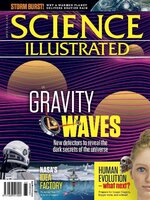Science Illustrated delivers natural science, break through discoveries and an understanding of the world for the entire family. Packed with stunning photography and in-depth editorial it’s a visually spectacular gateway to the world looking into the beginning of life to distant objects in the universe.
Reader Survey 2021 • Complete our Reader Survey for your chance to WIN this Science Illustrated mini library!
Science Illustrated Australia
Jelly babies: photographer captures bee birth up close
Screen test: world’s biggest camera shoots a vegetable
Venus still has volcanic activity • Using a new computer model of volcano development and 25-year-old radar data, scientists are now convinced that there is still active volcanism on the hostile planet.
Pigs reverse human lung damage • Scientists have discovered that a supply of pig blood can not only keep human lungs fresh for transplant recipients, it can actually restore the condition of lungs rejected as unviable.
Can clouds really ‘shine’ at night? • “When visiting Europe I saw shining clouds hovering in the sky long after sunset. Where does the light come from, and why have I never seen this in Australia?”
Why do some people walk in their sleep? • “I have read that children are more likely to sleepwalk than adults. Is this true, and why do some people sleepwalk while others don’t?”
… piranhas can consume you in five minutes? • Many myths exist about piranhas and their greed. There are certainly some alarming teeth inside a piranha mouth. But could these fish really convert a human being into a skeleton in just five minutes?
How are deserts formed? • All of Earth’s continents have deserts, but how did they originate? And why are they located where they are?
Are satellites visible from Earth? • Is it possible to spot satellites in the night sky with the naked eye?
Can acid dissolve a body? • “On crime shows, the bad guys often use acid to dissolve a body and dispose of evidence. Is it really that easy?”
COSMIC STORMS IN SPACE • In 2020, astronomers recorded the aftermath of the most powerful explosion ever observed, when a quasar emitted gases at 13% of the speed of light. It’s now thought that cosmic storms from quasars may provide answers to some of the universe’s biggest mysteries.
Dust and gas spark a quasar • Quasars light up when huge supermassive black holes relentlessly suck up dust and gas. Before the gases disappear into nothingness, they light up to utter one last desperate death scream.
Hubble studies quasar gas storms • The light from the quasar is so intense that the light pressure blows a storm of gas through the galaxy. The Hubble Space Telescope has observed 10 quasars, revealing gases travelling at speeds up to 21,000 kilometres per second.
The strange quandaries of quasars • When the first quasar was discovered 60 years ago, it proved the existence of black holes. Since then, more than a million quasars have been observed, but they still pose unanswered questions – such as why quasars originated earlier than should have been possible.
THE DOOMSDAY GLACIER • A glacier three times the size of Tasmania is being consumed by warm ocean water. If it disappears, all of West Antarctica is threatened, and ocean levels could rise by up to 3 metres. An expedition is trying to determine how close we have come to disaster.
The entire ice sheet could end up in the ocean • The Thwaites Glacier and its neighbour, the Pine Island Glacier of West Antarctica, are both threatened by collapse. If that happens, nothing will restrain the seaward ice flow.
Warm water and air break down the ice sheet • Ocean water at 2°C is gaining access to the boundary between the floating ice shelf in front of the Thwaites Glacier and the...

 Issue 106
Issue 106
 Issue 105
Issue 105
 Issue 104
Issue 104
 Issue 103
Issue 103
 Issue 102
Issue 102
 Issue 101
Issue 101
 Issue 100
Issue 100
 Issue 99
Issue 99
 Issue 98
Issue 98
 Issue 97
Issue 97
 Issue 96
Issue 96
 Issue 95
Issue 95
 Issue 94
Issue 94
 Issue 93
Issue 93
 Issue 92
Issue 92
 Issue 91
Issue 91
 Issue 90
Issue 90
 Issue 89
Issue 89
 Issue 88
Issue 88
 Issue 87
Issue 87
 Issue 86
Issue 86
 Issue 85
Issue 85
 Issue 84
Issue 84
 Issue 83
Issue 83
